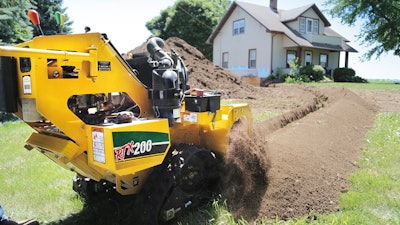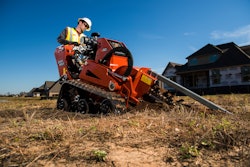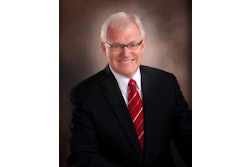
With so many people working and entertaining more at home this past year, backyard home improvement projects have had landscape contractors keeping busy with an uptick in work. And, for many rental stores, increased landscaping jobs translates to increased demand for smaller, residential landscaping equipment.
These machines can complete a variety of projects, from installing irrigation systems to keeping the lawn looking great to burying shallow electrical lines for outdoor lighting. Among the most commonly rented machines for these backyard projects are pedestrian trenchers (or walk-behind trenchers).
During busy rental periods, it’s important to evaluate the pedestrian trencher models you currently have in your fleet to determine which ones your customers like the best — and whether you need to expand your fleet to keep up with the demand for these machines.
 Rental stores should also consider investing in optional accessories like tracks, a backfill blade, and boring attachment. Tracked pedestrian trenchers may cost a little more than wheeled units, but they deliver optimal flotation and traction on the job.Vermeer
Rental stores should also consider investing in optional accessories like tracks, a backfill blade, and boring attachment. Tracked pedestrian trenchers may cost a little more than wheeled units, but they deliver optimal flotation and traction on the job.Vermeer
“With small machines like pedestrian trenchers, a contractor’s overall rental experience can be impacted — negatively or positively — by small configuration adjustments,” he said. “For example, the wrong type of chain configuration can mean the difference between a project taking a couple of hours or a whole day. Getting those small details right will make for a better working experience and can help drive repeat business.”
To deliver that optimal rental experience for new customers, as well as faithful long-time customers, Bonnema offers insights on what you should consider when evaluating your pedestrian trencher fleet ahead of adding more units.
Who are the most common users of pedestrian trenchers, and how are they using them?
Pedestrian trenchers rentals typically come from professional contractors and backyard renovation projects driving the bulk of usage for the rental industry. The products being installed are mostly waterlines for irrigation systems and electrical lines for outdoor lighting and power. Other uses include installing cable and fiber conduit, gas lines, and shallow small-diameter drainage tile, as well as digging perimeter footings.
Why would a professional landscape contractor rent a trencher instead of buy one?
Many landscape contractors specialize in lawn maintenance work, only offering irrigation or hardscape services when approached by an existing customer. For those types of contractors, renting a pedestrian trencher a few times a year makes more economic sense than owning a machine.
Contractors may also consider renting a small pedestrian trencher because of jobsite space constraints. For example, mini skid steer loaders and larger loaders are often the machine of choice for a landscape contractor, but the footprint of a pedestrian trencher is narrower than most tool carriers. So, if a gate is narrow or a trench needs to be dug close to the base of a building or a fence, a pedestrian trencher is probably the better trenching option. Also, a walk-behind trencher has a light footprint for optimal flotation in sensitive ground conditions, which can help reduce remediation work for a contractor.
How much horsepower do I need to offer customers?
The pedestrian trencher product category starts at around 13 horsepower (9.7 kW) and extends to 25 horsepower (18.6 kW). Determining which models to offer customers will depend on the area’s ground conditions, climate, and rental customer mix.
 Rental store staff should always ask customers how deep of a trench they need to dig.Vermeer
Rental store staff should always ask customers how deep of a trench they need to dig.Vermeer
Another consideration to keep in mind: Experienced operators tend to get the most from the machine, no matter the horsepower..
What’s the right boom size to outfit a trencher with?
Pedestrian trencher booms are typically 24 inches, 30 inches, 36 inches, or 48 inches in length. In softer soil conditions, small pedestrian trenchers (up to 20 horsepower) are productive at digging up to 36 inches. Larger units should be used if a trench needs to be deeper than that.
Rental store staff should always ask customers how deep of a trench they need to dig. For example, suppose the trench depth requirements are close to the boom length. In that case, it’s a good idea to send out a machine with a little larger boom to make sure they reach their desired depths, especially when you factor in potential uneven terrain and material possibly falling back into the trench.
How do I decide what kind of chain to outfit pedestrian trenchers with for the ground conditions?
The first thing to consider when thinking about the chain on the pedestrian trencher is trench width. In most cases, it’s a good idea to go with a chain configuration that gives operators the widest possible trench, unless you know the specific application. Pedestrian trencher changes are set up to dig between 4 inches and 8 inches wide.
In addition to choosing the correct width, you also have to determine the appropriate tooth type and pattern for the area’s soil conditions — teeth either cup or cut. Cupping teeth are designed to scoop material while cutting teeth break up or dislodge solid material like rock. Soil chains use cupping teeth, while rock chains use carbide-tipped cutting teeth. There are also combination configurations that use a mix of cupping and cutting teeth.
Tooth spacing can also have an impact on the digging performance. Closer tooth spacing is ideal for more challenging ground conditions, and broader tooth spacing can be more efficient when working in soft grounds.
What features do I look for to help deliver an optimal operator experience?
To improve the rental experience for customers, there are a few things you should look for when investing in pedestrian trenchers. First, the trencher controls: They need to be intuitive and responsive. Every operator wants to be able to quickly adjust to the operator controls of the machine, so choosing one that is convenient to use is one of the best ways to give customers a superior rental experience. One of the areas where user-friendly controls is most apparent is when making turning adjustments. For example, Vermeer pedestrian trenchers feature VZ steering, which gives operators the ability to make precision turns using only handlebars instead of levelers. These bars also provide additional leverage when operating in difficult terrain.
Also, the weight and balance of the trencher can significantly impact how productive the machine is in challenging soil conditions. For example, when working in solid clays or cobble conditions, the ground material can affect the productivity of lighter machines. Slightly heavier machines with the right balance will help keep the boom digging productively.
Rental stores should also consider investing in optional accessories like tracks, a backfill blade, and boring attachment. Tracked pedestrian trenchers may cost a little more than wheeled units, but they deliver optimal flotation and traction on the job. Adding a backfill blade gives renters the ability to quickly fill a trench and may result in longer rentals because of that versatility. Also, boring attachments provide the operator the ability to cross under sidewalks and driveways.
What tips do you have for rental stores to ensure a customer’s rental experience goes smoothly?
To ensure rental customers have the best rental experience possible with your fleet of pedestrian trenchers, it’s essential that you prioritize routine maintenance on these machines. For instance, when a pedestrian trencher is returned, it should be inspected to check everything is in good working order, the chain is tensioned correctly, and the teeth are in good shape. Refer to the machine’s operator’s and/or maintenance manual for machine-specific maintenance procedures.
 In colder climates where a utility needs to be installed deeper than the frost line, or your customers are working in harder clays or soils with cobble, extra horsepower can be a real benefit.Vermeer
In colder climates where a utility needs to be installed deeper than the frost line, or your customers are working in harder clays or soils with cobble, extra horsepower can be a real benefit.Vermeer
Investing in a pedestrian trencher trailer is another way to help the renting experience for the customer, since many renters may not have their own to load it on.
With a booming landscape market, retaining new customers should be a top priority. Taking the time to choose the optimal pedestrian trencher model for your customers’ needs and configuring it to match their working conditions are the best ways to deliver a positive rental experience and grow your customer base.




















